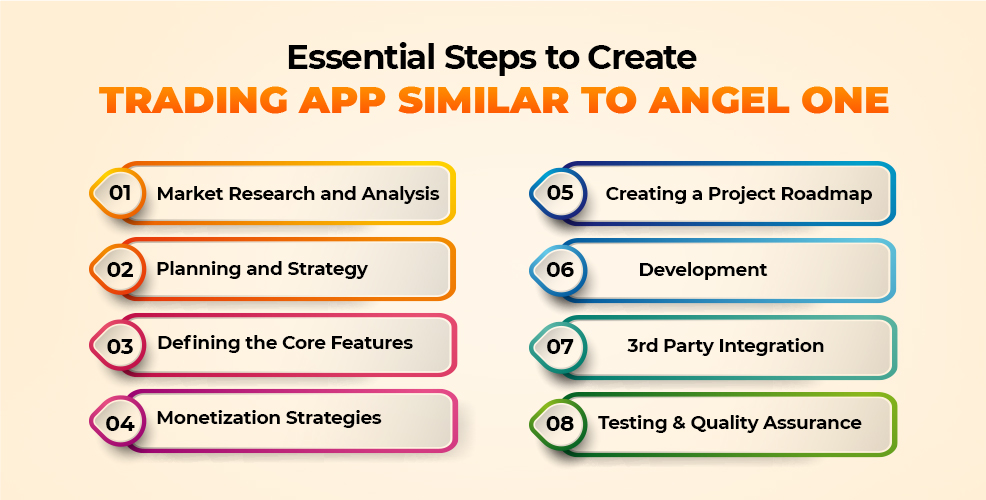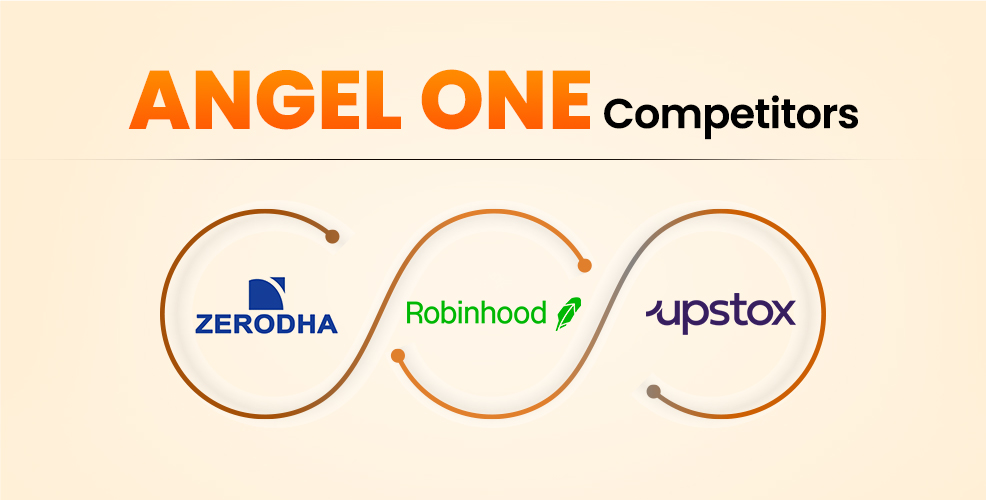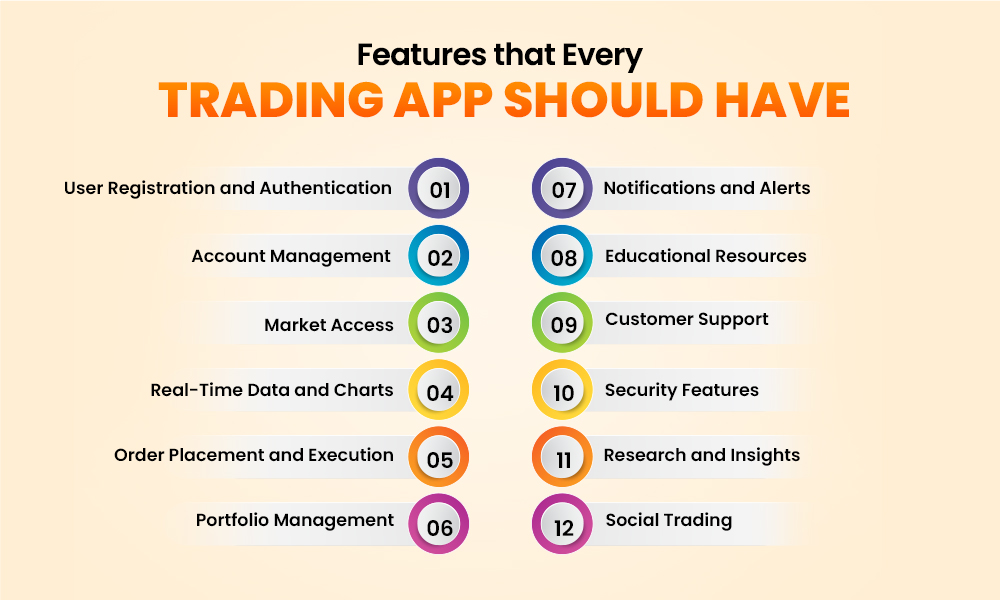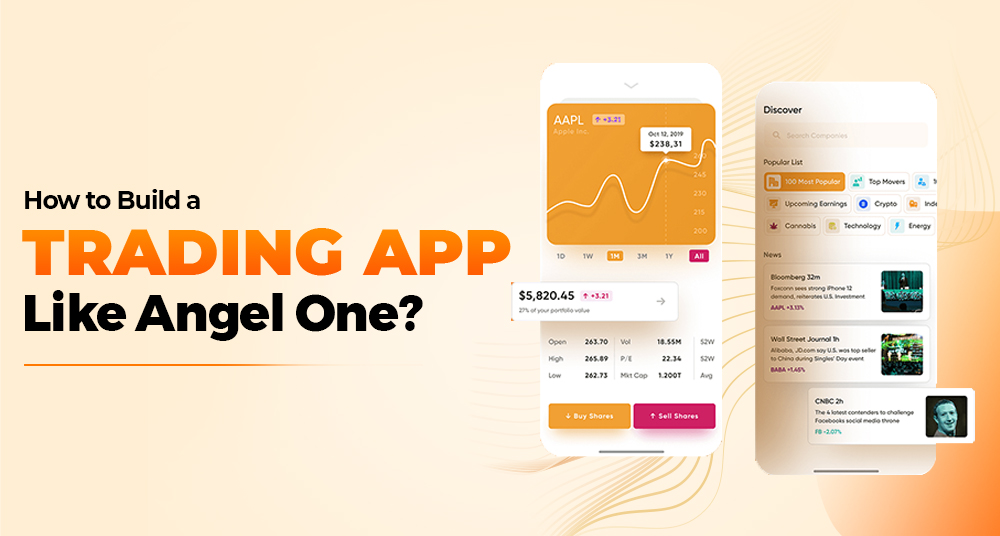People now use trade apps to change how they invest in the stock market. These apps let anyone with an internet-connected smartphone exchange currencies, stocks, commodities, and other financial things from anywhere in the world. There are many trade apps out there, but in India, Angel One is one of the best-known. There are lots of tools on it that can help everyone.
Overview of Trading Apps
Trading apps are parts of software that let you lease, buy, and sell futures, stocks, and bonds. People who buy these apps get study tools, easy-to-use platforms, and market knowledge in real time. This makes trades smart.
Key Steps to Build a Trading App Like Angel One

Market Research and Analysis
To make sure that a trading app like Angel One meets users’ wants and stands out in a crowded market, it’s important to do a lot of research and study the market. This part will talk about finding the target group, looking at the competition, knowing market trends, and why user feedback is important.
Identifying the Target Audience
Any trade app that wants to be successful needs to know who its users are. If you want to buy something, you can use a trade app. It doesn’t matter how much you’ve bought before. Keep these things in mind as you try to figure out who the target group is.
- Demographics: Find out how old people are, what gender they are, how much money they have, and where they are likely to live. Most people who have extra money and want to buy something use this app between the ages of 18 and 45.
- Experience Level: Put people into groups based on how much they know about shopping. Traders who are just starting out may need an interface that is easy to use and teaching materials. Traders who have been trading for a while may want more advanced features and analysis tools.
- Investing Goals: Want to invest? Find out what the people you want to invest in plan to do with their cash. How do they want to spend their money? Do they want to trade on the short term, on gambling, or for the long term? This will help make the features of the app fit their wants.
Analyzing Competitors
Watch what your competitors do to find holes in the market and come up with something that makes your trade app stand out. To do a competition study, follow these steps:

- Find your main competitors: apps like Zerodha, Robinhood and Upstox are the biggest rivals of Angel One. You should list both direct and secondary rivals.
- Look at the features and functions: Look at the functions and features that your rivals offer. Find out why their apps are so well-liked and what features they could add or make better.
- What people have said and reviewed: Look at what other people have said about competing apps in app shops and on websites to get an idea of what they like and don’t like about them. You can use it to learn what people are having issues with and how to fix it.
- Price Setting and Making Money: Look at how your companies set their prices and how they make money. Find out if they make money by running ads, giving away extra services, or charging fees.
Importance of User Feedback
User feedback is one of the best ways to make your trade app better. It gives you straight information about how users feel, what they like, and where they’re having trouble. Here are some ways to get feedback from users and use it:
- Test the Beta: Test the app with a small group of people in beta mode before you make it public. Listen to what people have to say about the app’s features, how well it works, and how simple it is to use. Then make the changes that are needed.
- Tests and Polls: Ask a lot of people for help with tests and polls. Do not be vague when you ask about the app’s look, features, and general functionality.
- Reviews from Users: Read reviews from users on app stores and reply quickly to comments. Taking care of user complaints and using their ideas can help the app’s image and make users happier.
- In-App Feedback: Add a way for users to give feedback within the app so that you can fix problems or add features directly. This can give real-time information and help set priorities for development work.
Planning and Strategy
Making a trading app like Angel One that works well requires a lot of planning and strategy. Setting clear goals, describing key features, choosing ways to make money, and making a project plan to help the development process are all parts of this.
Setting Clear Objectives
Making goals is the first thing that needs to be done to make a project work. For a trade app, these goals should fit in with the overall business plan and goals. Remember these important goals:
- User Acquisition: Set goals for how many new users you want to get in a certain amount of time, like a million in the first year.
- Market Penetration: Try to get a certain amount of the trade app market.
- User Engagement: Setting goals for session time, daily active users (DAU), and monthly active users (MAU) are all good ways to find out how involved users are.
- Setting sales goals: Make money goals, like making a certain amount of money in the first year by finding different ways to make money.
- Feature Rollout: Make a plan for when to release important features and functions.
Defining the Core Features
It’s important to define the main features of trading app development so that it meets user needs and stands out from others on the market. Here are some important things to include:
- Registration and verification of Users: The sign-up process is safe and easy, and you can choose to use multiple forms of verification.
- Account Management: Full control over each user’s account, including changing settings for their biography, adding bank accounts, and verifying documents.
- Market Access: Being able to buy stocks, commodities, foreign exchange, and cryptocurrencies in real time means having market access.
- Real-Time Charts and Data: Live market data, live charts, and expert tools can help traders make smart choices.
- Placement and Execution of Orders: You can place market, limit, stop-loss, and range orders quickly and reliably.
- Portfolio Management: This includes tools like performance data and profit/loss records for keeping track of and handling financial assets.
- Messages and Alerts: You can set up your own messages and alerts for things like price changes, order execution, news updates, and more.
Monetization Strategies
Choosing the right ways to make money is very important if you want your trading app to stay in business. Some common ways to make money that you might want to think about are:
- Commission-based: For every trade made through the app, charge a commission fee. This is a common way for trading companies to make money.
- Paid Subscriptions: Use paid subscription plans to give away extra benefits and services. People can pay a fee every month or once a year to get access to advanced tools, real-time data, and special material.
- Buys inside the app: Make it possible for users to buy extra features like trade alerts, advanced tracking tools, and study reports.
- Advertising: Make money by putting ads inside your app. Work with finance firms, financial service providers, and other related companies to put up ads.
- Referral Programs: Set up a program where users can get prizes for getting new people to download your app. This can get more people to use the site and keep them there.
Creating a Project Roadmap
A project plan shows how long it will take to trading app development and what the important steps are along the way. It helps keep the job on track and gives a clear plan of what to do. To make a project plan, follow these steps:
- Explain phases: Split the project into clear steps, like planning, designing, building, testing, and launching.
- Mark your progress: Set important goals for each step, like finishing the layout, beta testing, and getting approval from the government.
- Divide up the resources: Give coders, artists, testers, and project managers, among others, jobs and duties.
- Schedule and Due Dates: Set a reasonable schedule with clear due dates for each step and achievement. Be flexible so you can deal with problems that come up out of the blue.
Core Features to Include
For a trading app like Angel One to be successful, it needs to have certain features that meet users’ wants and make dealing better. Here are the most important things to include:

1. User Registration and Authentication
- Secure Sign-Up: Accept email, phone, and social media signups.
- KYC Verification: Integrate KYC procedures to verify users’ identities and obey the regulations.
- Multi-Factor Authentication (MFA): Secure your account with MFA.
2. Account Management
- User profiles: It allows users take care of their data, settings, and interests.
- Bank Account Linking: Make it easy for people to link their bank accounts so that money moves go smoothly.
- Document share: Give people a safe way to share the papers you need to verify their identity.
3. Market Access
- Real-Time Market Data: Give live information on cryptocurrency prices, stock prices, the stock market, commodities, and foreign exchange.
- Market Listings: Give people access to many markets and exchanges so they can trade many different types of financial products.
4. Real-Time Data and Charts
- Interactive Charts: Include charts that can be changed and that have more than one-time frame and technical signs.
- Technical analysis tools: Moving averages, Bollinger bands, MACD, and RSI may help you examine the market.
5. Order Placement and Execution
- Order Types: Market, limit, stop-loss, and bracket orders are some of the order types that can be used.
- Fast execution: Take advantage of market opportunities by executing orders fast and reliably.
- Order History: For future reference and research, keep a full record of all interactions for each user.
6. Portfolio Management
- Investment Tracking: Allows users to monitor the performance of their investments in real time.
- Profit/Loss Statements: Generate detailed reports on gains and losses.
- Asset Allocation: Provide tools for managing and diversifying investment portfolios.
7. Notifications and Alerts
- Price Alerts: Enable users to set alerts for specific price movements.
- Order Notifications: Notify users of order executions, modifications, and cancellations.
- News Updates: Provide timely news updates and market insights relevant to user interests.
8. Educational Resources
- Tutorials and Guides: Teach trading fundamentals and advanced tactics.
- Webinars and Live Sessions: Ask market experts questions live.
- Simulation Mode: Let users practice trading without risking real money.
9. Customer Support
- In-App Chat: Add live chat for client assistance.
- Email and Phone Support: Allow consumers to contact assistance via email and phone.
- Help Center: Create a comprehensive help center with FAQs, troubleshooting instructions, and support articles.
10. Security Features
- Data Encryption: Protect user data with end-to-end encryption.
- Secure Login: Use fingerprint or face recognition authentication.
- Fraud Detection: Integrate fraud detection to detect and prevent suspicious activity.
11. Research and Insights
- Financial News: Integrate financial news feeds from reputable sources.
- Market Analysis: Provide detailed market analysis and research.
- Trading Tips: Share professional trading advice.
12. Social Trading
- Follow Traders: Allow people to follow and learn from successful traders.
- Duplicate Trading: Automatically duplicate expert trades.
- Community Forums: Create discussion boards for users to exchange ideas and tactics.
Developing the App
Setting up the development environment and adding third-party services are two of the most important steps in making a trade app like Angel One. Setting up the development environment, using an agile method, and working on both frontend and server development are some of the most important steps in trading app development that are covered in this part.
Related Blog: Essential Steps to Build a Mobile Application
Setting Up the Development Environment
The programming setting is very important for writing code, testing it, and working together. To set up a strong work setting, do the following:
- Version Control System: Use Git to monitor code changes and collaborate. Hosting files on GitHub or GitLab may assist.
- IDE: Choose one that works with your technology. Popular options include Visual Studio Code, IntelliJ IDEA, and Android Studio.
- Tools for Project Management: Use Jira, Trello, or Asana to monitor progress, organize tasks, and meet targets on time.
- Jenkins, CircleCI, or GitHub Actions may be used for CI/CD processes to test and deploy.
- Development Tools: Select front-end (React Native, Flutter) and back-end (Node.js, Django) development tools.
Agile Methodology and Sprint Planning
Agile development improves flexibility, collaboration, and efficiency. Do this to utilize agile:
- Plan in sprints: Break the job up into chunks that are about two to four weeks long each. Each sprint should have defined objectives, tasks, and outcomes.
- Daily Stand-Ups: Discuss accomplishments, issues, and daily goals in daily stand-ups.
- Sprint Reviews: Reviewing sprint work with partners and gaining their feedback will influence the next sprint.
- Retrospectives: Sprint retrospectives help assess what worked, what didn’t, and how to improve future sprints.
- Management of the queue: Keep a product queue with features, user stories, and bug fixes that are ranked by importance. Make changes to the list often based on comments and new needs.
Frontend Development
The app’s UI and UX are handled by this section. Here are the key front-end construction steps:
- Picking Out a Framework: Choose a front-end system that lets you build apps that work on multiple platforms. Building fast mobile apps with React Native and Flutter is a popular choice.
- UI/UX Design: Make wireframes, models, and prototypes with the help of artists. Focus on making a system that is easy to use and looks good.
- Design that adapts to different screen sizes and devices: Make sure the app works well on all of them.
- Component Development: Make UI components that can be used again and again to keep things consistent and make the code easier to manage.
- State Management: Redux and MobX make app state management easy.
- Integration of APIs: Integrating server services and third-party APIs lets you get real-time market data, conduct trades, and manage user accounts.
Backend Development
The business logic, data keeping, and interaction with outside services are all taken care of by the core of the app. Here’s how to go about developing the back end:
- System Choice: Pick a server system that works for you. A lot of people choose Node.js, Django, and Ruby on Rails.
- Database Design: Make a database design that can be expanded and works well. You may use PostgreSQL, MySQL, or MongoDB depending on your needs.
- API Development: Create GraphQL or RESTful APIs for front-end-server communication.
- Authentication and Authorization: Set up safe ways to authenticate and authorize users. Employ OAuth, JWT, or other well-known standards in the field.
- Real-Time Data: Use WebSocket or similar technology to send changes and alerts about real-time market data.
- Third-Party Integrations: Connect to outside services like payment platforms, market data companies, and Know Your Customer (KYC) identification services.
- Scalability and Performance: Make sure that the backend is scaleable and performs well. To handle a lot of traffic and data, you can use load balancers, caching, and database storage.
Integrating Third-Party Services
Adding third-party services to your trade app can make it work better. These are some important integrations:
- Providers of Market Data: Use Alpha Vantage, IEX Cloud, or Yahoo Finance as sources to get market info in real-time.
- Payment platforms: To make sure deals are safe, use payment platforms like Stripe, PayPal, or Razorpay.
- KYC Verification: To make the process of verifying users easier, connect your app to KYC verification services like Jumio or Onfido.
- Notification services: There are services like Firebase Cloud Messaging (FCM) and OneSignal that can be used to send push messages and alerts.
- Analytics Tools: Use Google Analytics, Mixpanel, or Amplitude or other analytics tools to keep track of how users behave and how well your app works.
Testing and Quality Assurance
Make sure the app works well and doesn’t have any bugs. This is how you should go about testing and quality assurance:
- Unit Testing: To make sure that individual parts and methods work, you need to write unit tests.
- Integration Testing: Make sure that the different parts work together as planned by testing how they are put together.
- System trying: Make sure the app works from beginning to end by trying it from end to end.
- Testing to see if users are happy (UAT): Test with real people to get feedback and find any problems with usefulness.
- Automatic Testing: Use automatic testing to make the testing process go faster and make sure the results are always the same.
- Load Testing: Run load tests to see how well the app works when there is a lot of traffic and find any problems.
If you follow these steps, you can make a trade app like Angel one that is strong, safe, and easy for people to use that meets the needs of your target audience and stands out in the market.
Conclusion
Making a trade app like Angel One is a long process that needs careful planning, making smart decisions, and following through with your plans. You can build a strong base for your app by studying rivals, knowing and focusing on the right audience, and following market trends. Making sure you follow financial rules, putting data security and privacy first, and getting all the rights you need are all important steps that will help your users trust and believe in you.
During the creation phase, it’s important to make a thorough project plan, use agile methods, and add features that meet market needs and improve the user experience. A strong front end and server, the addition of third-party services, and strict testing procedures will lead to a high-quality and dependable trading app.






What do you think?
It is nice to know your opinion. Leave a comment.